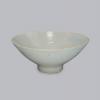Fragment of the Rose Tapestries, wool and silk (1480s)
External links
Commentary
This tapestry fragment is one of four kept in the College’s possession, thought to originally be from a single hanging. The ‘IHS’ depicts the first three letters of Jesus’s name in the Greek alphabet (ΙΗΣ). It is not certain who the tapestry was made for and why. On some of the other fragments are shields with the device of the three gold crowns, which are associated with the legendary King Arthur, the namesake of Henry VII’s eldest son. It has been suggested that the tapestry was made to commemorate Prince Arthur’s baptism in 1486 in Winchester Cathedral. Each of the tapestry fragments is woven with vertical blue and red stripes interlaced with a repeating pattern of pomegranates. These details have led the art historian Thomas P. Campbell to suggest that it commemorated Prince Arthur’s betrothal of Katherine of Aragon, whose coat of arms contained said fruit.
This tapestry is a product of the extensive trade networks that crossed Europe in the late medieval period. Woven in the Netherlands, it is made of European materials: wool from England or Spain, and silk from Spain or Italy. The dyes (madder, woad, weld) are from plants that were grown across Europe. From the sixteenth century, the availability of new dyes and materials from the New World expanded the possibilities for tapestry production. Not long after this tapestry was made, the introduction of indigo from India and cochineal from South America introduced deeper blues, brighter reds, and deeper shades of purple to the wool dyer’s colour palette.
Sources
James Webster, ‘Rose Tapestries, 1480s’, in Richard Foster (ed.), 50 Treasures from Winchester College (London, 2019), pp. 70–71.
Elena Phipps, ‘Global Colors: Dyes and the Dye Trade’, in Amelia Peck (ed.), Interwoven Globe: The Worldwide Textile Trade, 1500–1800 (New York, 2013), pp. 121–35.

